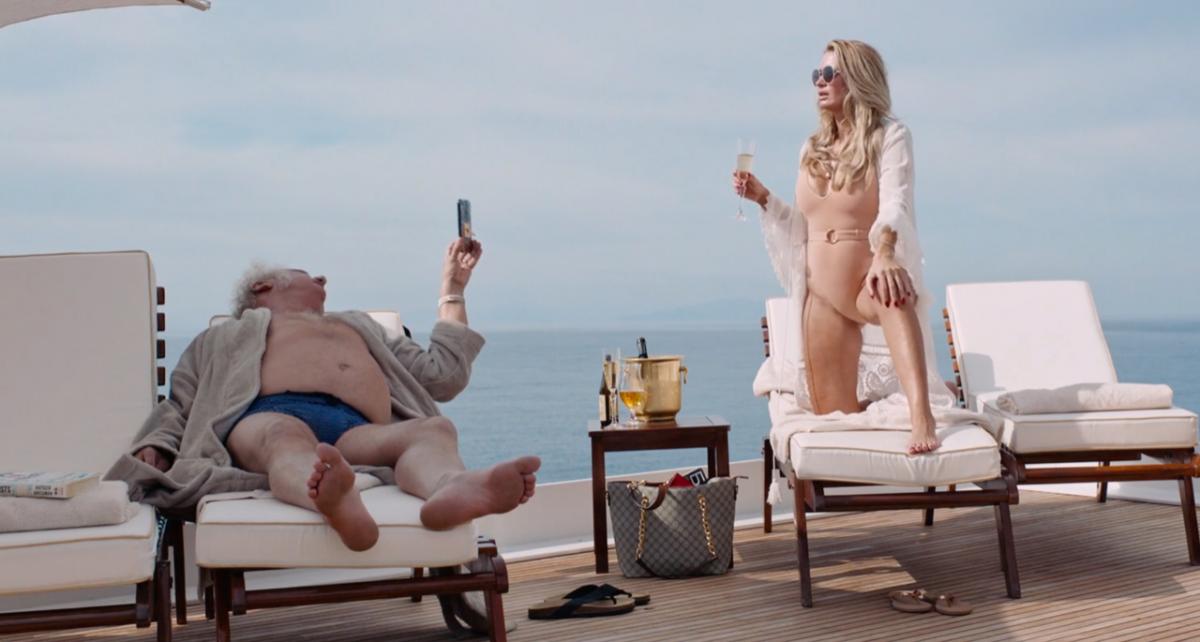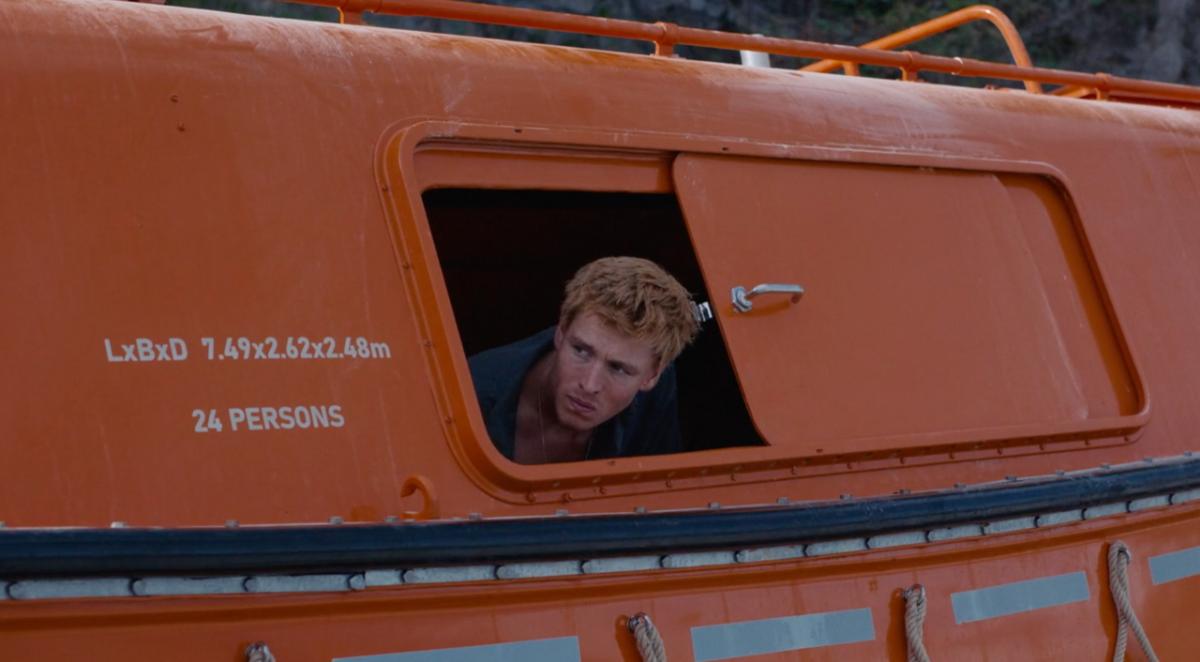Ruben Östlund’s Triangle of Sadness, a Post-Ideological Mire
After flaying the art world in The Square (2017), Ruben Östlund now sets his sights upwards with Triangle of Sadness (2022). In this black comedy, it is the richest one percent who are targeted. The common thread running through this three-part satire is a couple, an influencer named Yaya and model named Karl. The first part of the film is inspired by a discussion between the Swedish director and his wife about paying a restaurant bill. “It’s not about the money,” Karl complains after having to get out his credit card two nights in a row. “But we shouldn't just slip into the stereotypical gender-based roles everyone else seems to be doing. I want us to be equal.” What began as an innocent remark escalates into an aimless discussion of gender patterns. Östlund seems to suggest that identity too often distracts us from the real cause of inequality: money.
In the second part of the film, Yaya’s influencing capital earns the couple a trip on a cruise ship. While they are sipping cocktails on the upper deck with some of the richest people on earth, the crew below deck is getting ready for their shift. “No excuses, it’s always yes, sir, yes ma’am,” we hear. “If everything goes well, you might be getting a very generous tip.” To which the crew starts wildly stomping their feet, roaring “Money, money, money!” in unison. Money: a small part of the ship has it, the rest of the ship wants it. The cruise serves as a patently obvious allegory for capitalism. Östlund shows himself to be an adept satirist, especially in the portrayal of upper-deck adventures. He mercilessly observes the absurd behaviour of an English arms dealer, a Russian oligarch and a lonely computer scientist, sardonically revealing the immoral views behind their excessive lifestyles. In this farce about the habits of a class, Luis Buñuel is always lurking around the corner.

The ship ultimately runs aground, and with it the film. When the motley crew washes up on a desert island, the class relations are given a thorough shaking. Torn from their familiar world, the arms dealer, the oligarch and the computer scientist end up at the bottom of the pile. When Abigail, a member of the cleaning staff, turns out to be the only one who can fish and cook, she installs a matriarchy with sex and pretzels as currency. As her power grows, she adopts an increasingly decadent lifestyle, indulging in the same immoral excesses as the rich people on the ship. The latter, in turn, advocate equality and redistribution: “From each according to his ability, to each according to his needs.” Their sorry plight in one fell swoop turns them into Marxists.
This last part of the film in particular is explicitly intended as social criticism. Triangle of Sadness aims to raise, reveal and criticise issues, and was almost unanimously lauded as “subversive”, “committed” and even “visionary”. Östlund was going to bring us to ourselves and open our eyes. Thierry Frémaux, the director of the Cannes Film Festival, called him “a funny metaphysician who questions the world we find ourselves in”.1 The filmmaker himself, too, aims for social change with his film. He wants people to “become more aware of the differences in society. I hope that prosperous people will think about that after seeing my film.”2
Cinema demarcates a fictional space, a microcosm within which filmmakers can experiment with existing structures. Unlike politicians, whose decisions concern the real world, the filmmakers’ experimentation is limited to the laboratory of film. Cinema has the potential to challenge “capitalist realism”. In his analysis of our contemporary world, Mark Fisher notes that it is easier to imagine the end of the world than the end of capitalism.3 Being a “representational” medium, cinema can compensate for that lack of imagination. Cinema addresses the viewer in this manner: “Imagine...” This representational role of cinema is twofold: it represents the existing world and at the same time suggests another world. A double movement takes place, whereby the representation of the past is at the same time a proposal for the future. This imaginative potential is most explicit in the genre of utopia, which, according to Frederic Jameson, is always characterised by a dialectical movement from the existing to the new.4
Östlund seems to employ a similar narrative strategy. The film moves from a satirical representation of the status quo (the ship in the second part) to what Jameson calls a “utopian enclave” (the island in the third part), where existing social relations are rearranged. But along the way the dialectic runs aground. The outcome does not say much about where we are really at, and even less about where we should go.
The allegorical set-up creates expectations and seems ideal for an ideological reading. From racism to gender equality, Östlund opens the door to different discursive spaces without actually entering them. The profusion of symbolism suggests abstraction but often turns out to be an empty signifier. The way Östlund refuses to fulfil the promise of meaning proves to be mostly manipulative. A filmmaker like Ernst Lubitsch, who made fun of the capitalism-shaped world in several of his films, more than anybody else knew how to play his audience by combining subtle suggestions with unexpected revelations. Lubitsch remained transparent about the “rules of the game”, however, and regarded the viewer, who willingly and happily allowed himself to be led astray, as an accomplice. In the cat-and-mouse game of Triangle of Sadness, the audience is never on equal footing with the filmmaker, who hides behind conceptual vagueness.

The film reaches the limits of its own imaginative power, because it does not go beyond the cynical observation that power corrupts. Östlund wants to put the opposition between capitalism and communism into perspective from a “neutral” position. He imagines himself to be the voice of reason in what is presented as an arbitrary debate between extreme ideologies. The class conflict as such becomes the object of ridicule, with which Östlund seems to announce the end of ideology.
The carnivalesque reversal of the hierarchy aims to shift our gaze from culture to economics, but the political spectacle that is being staged is just as rudderless as the identity politics that is criticised. What surfaces in the post-ideological mire of Triangle of Sadness is Francis Fukuyama’s thesis that the fall of the Berlin Wall marked the end of humankind’s ideological evolution and that capitalist liberal democracy rose the undisputed winner from the political battlefield of the Cold War. Although the 2008 financial crisis compelled Fukuyama to revise his own theory, Östlund presents the centrism of The End of History and the Last Man as a radical, disruptive critique, exactly twenty years after its publication.5
In Triangle of Sadness’s deterministic portrayal of humankind and the world, capitalism is not only the best but also the only possible social order. Even on a desert island, an enclave outside the dialectics of history, it covers the entire ideological horizon. Östlund's world – in which the players change places but the game remains the same – visualises the liberal and anti-revolutionary argument that the revolution of the proletariat inevitably leads to a continuation of the exploitation of an oppressed bourgeoisie by a vengeful working class. At the end, the film returns to the order of the day, all roads leading to neoliberalism’s “third way” between unbridled capitalism and revolutionary socialism. Östlund’s apparent inability to think outside the boundaries of capitalism seems rooted in unwillingness. When asked in an interview about his own ideological position, he replies that “there are good sides to capitalism that we should not forget”.6
Östlund seeks out the intersection of “intellectual” European cinema and commercial American cinema: “Just because you want to have an intellectually stimulating conversation doesn’t mean it can’t be fun.”7 However, the little get-together of the American, “Marxist” captain of the ship and the neoliberal Russian shows that politics is just a pretext for humour. They practice the sport of hurling jokes at each other about communists and capitalists – “The last capitalist we hang will be the one who sold us the rope (Karl Marx).” The references to Marx and Thatcher are supposed to intellectually justify the comic scene but the reversed re-enactment of the Cold War merely refers to an ideological debate from a safe distance, without actually taking part in it. The satire disguises a hollow anti-gesture, which takes the form of a social diagnosis whose politics serve a commercial purpose.
What seems innocent in terms of the content, becomes problematic in what Marshall McLuhan calls the broader “media-ecological” context: the way in which the media relate to the public’s views and actions.8 Along with other recent films and series such as The White Lotus, The Menu and Glass Onion, whose eat-the-rich angle puts the elite in the pillory, Triangle of Sadness is an example of how capitalism, as a way of self-preservation, incorporates and neutralises anti-capitalist discourses. The socially critical form creates the illusion that buying a ticket fights inequality. By presenting consumption as an act of resistance, revolutionary impulses are channelled and disarmed. It leads to what Fisher calls “interpassivity”.9 Cultural products are anti-capitalist in our stead, allowing us to continue consuming with impunity and complete peace of mind. If Triangle of Sadness encourages us to do anything, it is not to change lifestyles and not to question capitalism as the only possible option. The film intends to shock, but primarily reassures us with a night out.
- 1FCAD 2022 - Triangle of sadness - Thierry Frémaux speech, YouTube, 11 September 2022.
- 2Hugo Emmerzael, "Ruben Östlund over Triangle of Sadness: 'Arthouse-films zijn mij te stijf,'" Filmkrant, 07 December 2022.
- 3Mark Fisher, Capitalist Realism: Is There no Alternative? (Winchester: Zero Books, 2009).
- 4Fredric Jameson, Archaeologies of the Future: The Desire Called Utopia and Other Science Fiction (London: Verso, 2005).
- 5Francis Fukuyama, The End of History and the Last Man (New York: Free Press, 1992).
- 6Hugo Emmerzael, "Ruben Östlund over Triangle of Sadness,” 2022.
- 7Hugo Emmerzael, "Ruben Östlund over Triangle of Sadness,” 2022.
- 8Marshall McLuhan, Understanding Media (New York: Mentor, 1964).
- 9Fisher, Capitalist Realism, 12.
Images from Triangle of Sadness (Ruben Östlund, 2022)

